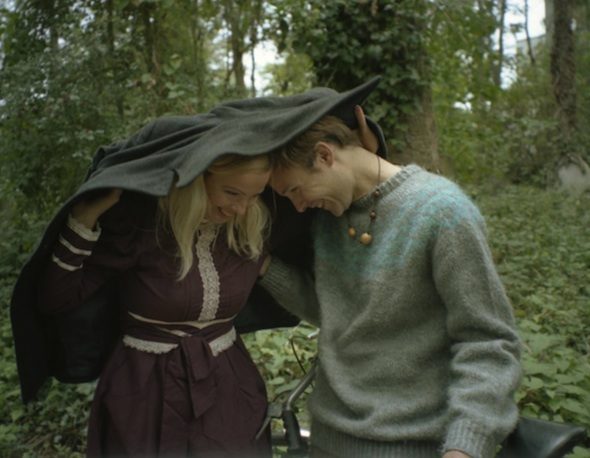 Lundahl&Seitl, Portrait; Photo by Gustav Almestål, courtesy of the artists
Lundahl&Seitl, Portrait; Photo by Gustav Almestål, courtesy of the artists
In July everyone in Scandinavia seems to go on mandatory vacation. Even in the art world, where the lines between work and non-work are constantly being blurred, it’s important to follow suit. As a result, Berlin Art Link spoke to Lundahl & Seitl (Christer and Martina, respectively) from a boat somewhere off the coast of Sweden. The soundscape of the interview was particularly fitting for the theme, as waves could be heard crashing in the background amidst the chatter of passengers and warnings from boat personnel.
We met the Stockholm-based artist duo in Moss, Norway in June at the opening of Momentum 8, where their interactive installation ‘Symphony’ was underway. The multi-sensory experience captured by the piece is not uncharacteristic of their work, which often plays on the tenuous borders of perception. In the interview, we discussed their theory of the viewer-as-medium and the idiosyncrasies of self-regulated, participatory artworks with no fixed outcome.
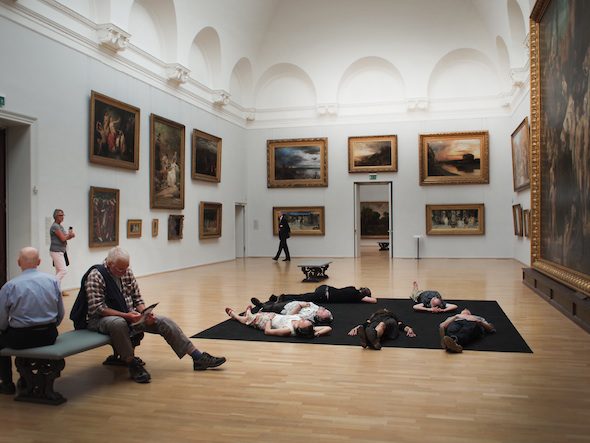 Lundahl & Seitl – “Symphony of a Missing Room” (2012), Hamburger Kunsthalle; Courtesy of Lundahl & Seitl
Lundahl & Seitl – “Symphony of a Missing Room” (2012), Hamburger Kunsthalle; Courtesy of Lundahl & Seitl
Alison Hugill: Your piece ‘Symphony’ at Momentum and, previously ‘Symphony of a Missing Room’ at Kunsthalle Bern, explores our pre-conceived ideas of the architecture and spatial layout of a museum or gallery. By activating the imagination of the participant, you ‘guide’ them through a fictional space. What is the aim of this project?
Martina Seitl: The work can be tackled from so many different angles. It’s almost like an empty vessel where it’s being filled with content from the imagination of the visitor. We offer the empty vessel or the form, and they fill it. People who experience the work very often speak about the design of trust. Basically, you have been deprived of your sense of vision and you are being guided by an unknown hand. These are people we work very closely with to choreographically embody architecture and different environments that are reflected in the three dimensional sound that the people are listening to, to support their inner imagination or vision. They say that the hand is very crucial: how can I trust a stranger?
Christer Lundahl: There’s a sense when you experience our work that it is actually not a person who is guiding you. There is a sense of engagement, for the visitor, with the whole body but I don’t think there’s much of a social presence of another person. It’s more of a facilitating role. That’s why we don’t call it a performance exactly, but an artwork. It’s not very different, to us, than film or installation. We work with very different materials: three dimensional sound, touch, gravity, changes in temperature. These are small, subtle changes of perception that we orchestrate or choreograph.
MS: As Christer said, we don’t want people to think about who the person is that is guiding them. People have said that it feels almost as though it’s just a hand, not a body. We also work with different techniques of how to create the illusion of more hands or more people, when it’s actually only one person.
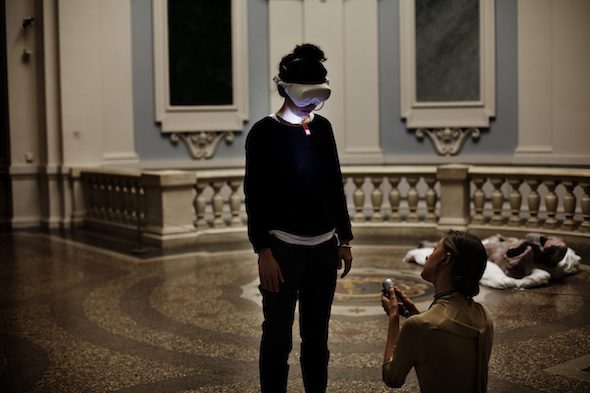 Lundahl & Seitl – “Symphony of a Missing Room” (2014), Bern Biennale; Image Courtesy LouLou D’Aki
Lundahl & Seitl – “Symphony of a Missing Room” (2014), Bern Biennale; Image Courtesy LouLou D’Aki
AH: The idea of the hand is quite intimate. If you think about the person you’re holding hands with, it could even be too intimate for some people. A lot of these themes you’ve mentioned – sensory deprivation, the disembodied voice, the guiding hand – come up in your other works.
CL: Yes, almost all of our works have this aspect of the guiding hand. ‘Symphony’ is all about making a presence out of things that are not there. In our latest project, ‘The Time of No Time’ – co-curated with Hanna Wörman and Kirsten Hinder – we want to reprogram our unconscious, habitual, collective and cultural misconceptions about space and the universe, with the hypothesis that it will affect our brain, perception, behavior, thinking, being and decision-making.
The concept communicated to the visitor is that ‘Time of No Time’ is an invisible cloud that is travelling, like a nomadic artwork, from place to place. You experience it on a website, which shows that perhaps the cloud is in Reykavik but is travelling towards your location in Kreuzberg. It will arrive over Berlin next Thursday at sunset. You would go to the location, download the app technology to use it, and when you turn it on the voice will tell you that you are now standing inside the cloud zone and that this is the artwork ‘Time of No Time.’ The project poses the question: How do we relate to things we have conceptual knowledge about existing around us, but our perception is not able to experience? For example, the earth’s rotation, or movement through space, relative to other celestial bodies. How do we relate psychologically and phenomenologically to the process of a sunset: the sun’s motion relative to the earth?
MS: We rarely think of the sky below our feet. We only relate to it as above us. So it’s about the way we think of our placement in the universe and things that we take for granted. When we were in school and we were taught the solar system, we learned it from a God’s perspective, and how the planets are in relation to each other. But we didn’t learn about where we are in relation to them.
The blue dot on Google maps is kind of similar: the question is whether the blue dot removes our natural sense of navigation. Maybe a few generations into the future we will no longer have that natural sense. Technology normally replaces our abilities but we want to use technology in such a way that it reintroduces the natural abilities of the body.
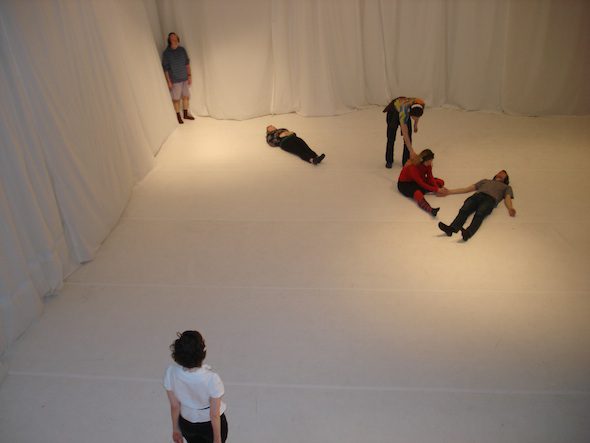 Lundahl & Seitl – Workshop, (2008), Weld, Stockholm; courtesy of Lundahl & Seitl
Lundahl & Seitl – Workshop, (2008), Weld, Stockholm; courtesy of Lundahl & Seitl
AH: Can you talk about the role of audience participation and performance in your work with reference to your theory of the viewer as the medium? What do you conserve of the artwork if it is temporal and fleeting in this way?
CL: Now it’s quite interesting because the Momentum Biennial decided to buy ‘Symphony’ from us. Now we have to figure out how to deliver our work so that some one can own it, so that we won’t have to maintain it constantly.
Martina’s background is as a choreographer and my background is in visual arts. I was always interested in the experience of the gallery or museum visit. In performance art you are often guided in time, within a narrative. I like the idea of directing the experience in the museum, of going from one work to another. A reference for that is Philippe Parreno‘s work of curating. But for us it’s about making the whole exhibition space inverted, or something internal. It’s partly built on the actual exhibition site – or in this case the concept of the Momentum Biennial was ‘tunnel vision’ – and partly we induce memories that came before the exhibition. We work a lot with archetypes so if you mention a gallery space, people have a sense of a vast blank space that they can imagine. In our work we talk about this exhibition space that nothing has ever been exhibited in; you walk up to a white wall and touch it. Then, later, when you go back to it the wall is gone. We ask them to touch the wall again and when they reach out, we take their hand and move it through the wall and into a forest.
MS: It’s almost like we’re simulating technology that doesn’t exist yet. It’s a very simple prototype. Actually, ‘Symphony’ was very low-tech; we were using MP3 players and headphones. But the technology we record with creates a really immersive sound experience. Then we work with changes of light on these white goggles.
CL: I never thought about it so much as sound but as image and space when we create our work. Even though we work with sound as one of our mediums, it’s always a sense of creating a space or environment. When we’re working with sound, touch, and movement we can create the sense of being in a real place. Your brain fills in the gaps.
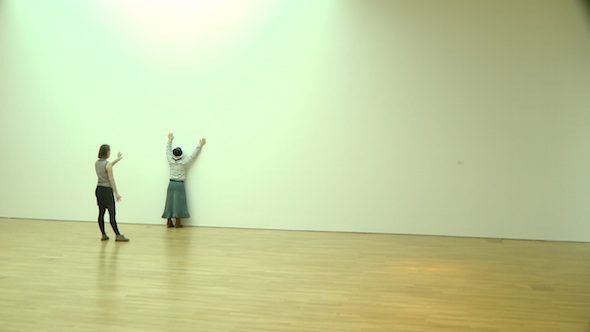 Lundahl & Seitl – “Symphony of a Missing Room” (2011), S.M.A.K Museum of Contemporary Art, Ghent, Belgium; Courtesy of Lundahl & Seitl
Lundahl & Seitl – “Symphony of a Missing Room” (2011), S.M.A.K Museum of Contemporary Art, Ghent, Belgium; Courtesy of Lundahl & Seitl
AH:There is an element of institutional critique in your work. What are you trying to say about the conventions of institutional spaces and the expectations we have of artworks and exhibitions?
CL: One thread in our work is that we often work in museums, galleries, art centres, theatres, cinemas. We went through all the major genres of culture. We look at the spaces where art is made and where it is shown, and how it has been historically connected to those places. How have those spaces made a certain kind of product or object? If you enter those spaces from a different vantage point, like in our case a trans-disciplinary practice, it starts to provoke a lot of the sediments that have stabilized on the ground of the institution. In our work, a lot of these things are moved up. A lot of history and restrictions, a certain way of doing things comes to the forefront.
MS: It is almost as if the institution itself exists within the artwork, both ‘Symphony’ and ‘Symphony of a Missing Room.’ When we started to record for ‘Symphony of a Missing Room’ we started in the National Museum in Stockholm in 2009. We recorded three-dimensional sound from this place and we went around to lots of others around Europe. Suddenly, we have a collection of museum sounds.
CL: It’s very difficult to talk about our work cause it has so much to do with the senses and how you experience certain things.
 Lundahl & Seitl – “The Infinite Conversation” (2011), Magasin 3, Stockholm; courtesy of Lundahl & Seitl
Lundahl & Seitl – “The Infinite Conversation” (2011), Magasin 3, Stockholm; courtesy of Lundahl & Seitl
AH: You said somewhere that absence is the trace that is left by your works.
MS: Yes, we call it ‘choreographing absence’ because we work with appearance and disappearance. We think a lot about the in-between spaces, the absence of the hand. The absence is more felt when you don’t see anything.
AH: This idea comes across a lot in the work of French philosopher Maurice Blanchot, whose book you reference in the title of your piece ‘The Infinite Conversation.’
CL: Yes, that was a piece for Magasin3 in Stockholm. The artwork is kind of a line of instructions, suggestions, a lot of different spaces that you walk through: it’s a very defined experience. Yet we haven’t fully created anything that you look at. The absence is the experience that the visitor will have.
AH: Do you see these projects as part of a bigger study of perception from a neuroscientific perspective?
MS: Yes. A big inspiration for our work has been a scientist called Henrik Ehrsson from the Karolinska Institute in Stockholm, who investigates the body’s sense of self. He created an out-of-body experience in the laboratory, where he tricked the body and the mind simultaneously. He did that by using virtual reality goggles, where you can see yourself from behind. It’s not just about seeing, though: he touches the front of the camera and the front of your chest, with a pen, in a similar movement. It makes your brain think that you are literally placed behind yourself, where the camera is. He’s been a source of inspiration. He also did the rubber hand experiment, where you feel a sense of touch from a doll’s hand, which your body thinks if your own hand.
CL: The great thing is that we have been able to continue our meetings with Henrik Ehrsson since 2008. At that time it was very taboo to make scientific work around body perception. It was not so high status, especially not for neuroscientists. Now, almost ten years later, we see how important it has been to have this research, especially in terms of how we can have a virtual presence. For example, in space navigation, but also in projecting your presence somewhere else. Henrik is also equally inspired by our work. It’s not that we always look at science, but science is also looking at art. It’s very important that art can also function as an inspiration to science.
MS: In our work, bodily states, which are very different, become almost like a musician’s score. Normally we think of the body as two-dimensional, and we think of what’s in front of us because we are ocularly-dominated. But we want to reintroduce the three-dimensionality of the body, to become aware of our backside or the volume of our bodies. It’s easier to choreograph those things when you’re blind-folded, or you work with sounds. We have our independent research, which is not necessarily scientifically proven, which gives us some freedom.
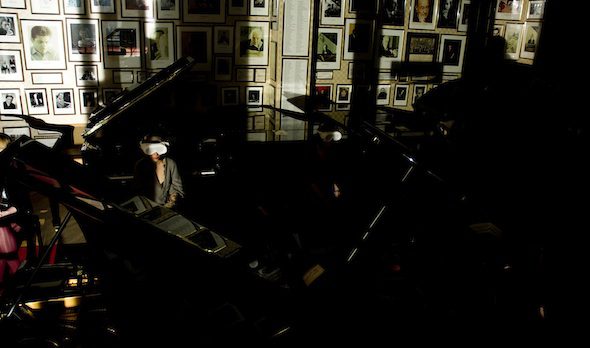 Lundahl & Seitl with Nomad – “THE MEMORY OF W.T. STEAD” (2013), Steinway & Sons Piano, W1 London; courtesy of Lundahl & Seitl
Lundahl & Seitl with Nomad – “THE MEMORY OF W.T. STEAD” (2013), Steinway & Sons Piano, W1 London; courtesy of Lundahl & Seitl
AH: It’s seems like a very exciting and fruitful part of your practice to have these cross-disciplinary collaborations.
CL: Yes, it was a very important thing at the beginning of our practice, something we were really seeking. Now it seems as though we have too many and we might need to close down on it; we’ve started to move away from art too much.
MS: It’s very important to leave your practice a bit and then re-enter it again and see how it has changed: to check in with yourself.
Additional Info
MOMENTUM 8 – NORDIC BIENNIAL OF CONTEMPORARY ART
Lundahl & Seitl: Symphony
Exhibition: Jun. 13 – Sep. 27, 2015
Henrik Gerners Gate 8, Moss, Norway, click here for map
Writer Info
Alison Hugill has a Master’s in Art Theory from Goldsmiths College, University of London (2011). Her research focuses on marxist-feminist politics and aesthetic theories of community, communication and communism. Alison is an editor, writer and curator based in Berlin. alisonhugill.com
























